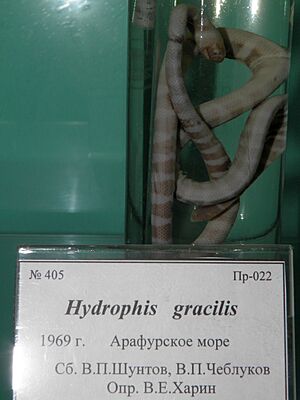Graceful small-headed seasnake facts for kids
Quick facts for kids Graceful small-headed seasnake |
|
|---|---|
 |
|
| Conservation status | |
| Scientific classification | |
| Genus: |
Microcephalophis
|
| Species: |
gracilis
|
| Synonyms | |
|
|
The Microcephalophis gracilis, also known as the graceful small-headed seasnake, is a type of sea snake. It lives in the warm waters of the Indian Ocean and Pacific Ocean. This snake is venomous, meaning it can deliver a dangerous bite. It's important to know about these snakes because they are found in many coastal areas.
What Does It Look Like?
The graceful small-headed seasnake has a very small head. Its body is long and thin, especially near the head. The scales on its body are close together.
This snake can grow quite long. Male snakes can reach about 95 centimeters (37 inches) in total length. Female snakes are a bit longer, growing up to 102.5 centimeters (40 inches). Their tails are also quite long, around 8 to 9.5 centimeters.
Where Does It Live?
The Microcephalophis gracilis lives along the coasts of the Indian Ocean and the western Pacific Ocean. You can find this snake in many places, including:
- Around the Persian Gulf (like Bahrain, Qatar, Saudi Arabia, Oman, United Arab Emirates (UAE), Iran, Iraq, and Kuwait)
- In countries like Pakistan, India, Sri Lanka, Bangladesh, Myanmar, and Thailand
- Across the Malay Archipelago and West Pacific, including Malaysia, Singapore, Cambodia, Vietnam, the Philippines, southern China, Hong Kong, and Taiwan
- It is also found in Australia (specifically Queensland) and Papua New Guinea
Staying Safe: Understanding Its Venom
The venom of the graceful small-headed seasnake is dangerous. A bite from this snake can be very serious. It's important to know that a bite often does not cause pain at first. This means someone might not even realize they have been bitten right away.
Symptoms usually start about 30 minutes after the bite. The venom mainly affects the muscles, which can lead to paralysis. This means the person might not be able to move their muscles properly. Other signs of a bite can include a headache, feeling very thirsty, and sweating. If someone is bitten, they need immediate medical help. It's always best to stay away from sea snakes and never try to touch them.


